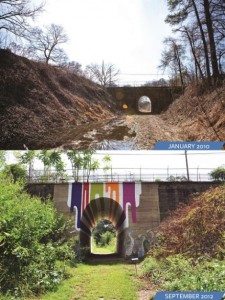
Before and After (Credit: Atlanta Beltline Organization, http://beltline.org/2015/04/09/the-atlanta-beltline-then-and-now/)
Just a few years ago, the Beltline possessed decidedly zero culture. Seriously, it was a jumble of abandoned railroads, empty parking lots, and deteriorating fields. Fortunately, to quote our most recent Nobel Laureate, “The times they are a-changin’.” In a matter of years, the Beltline has been transformed into a cultural epicenter for Atlanta.
As I documented in my previous description, the Beltline has taken empty space and tunnels and replaced them with a conglomerate of modern art, from statues to murals. Still, the culture of the Beltline expands so far beyond this.

An outdoor concert set up on the Beltline (Credit: Atlanta Insider Blog, http://www.atlanta.net/Blog/9-Things-to-Do-on-the-Atlanta-BeltLine/)
The Beltline has actually emerged as a popular spot for performance. The trail features several dozen performances every year, and, along with art pieces, the number continues to grow constantly. According to the Beltline’s website, the amount of art and performances increased from 30% in just one year from 2010 to 2011. On October 1 this year, the Beltline held a day of music event that included African dance and ragtime.

A picture of the Lantern Parade (Credit: Atlanta Beltline Organization, http://www2.atlanta.net/memberlink.asp?gotoPage=art.beltline.org/lantern-parade/)
And the path has developed its own traditions, namely the Lantern Parade. The September event had over 60,000 participants this year parading down the Beltline with many homemade lanterns.
Nevertheless, perhaps the most fantastic element of the Beltline’s culture comes from its everyday existence. Across the world, cities hold various special events that add to the culture of the town, yet a city is perhaps best defined culturally in what it has every day, like the Eiffel Tower or Statue of Liberty. Atlanta, and its penchant for tearing down and rebuilding, has long struggled in this regard. But the Beltline has taken the lead in changing this aspect of the city. For one, the trail has taken the city’s love of replacement and change and fed on it. The organization rotates exhibits annually. While the Beltline always has the same feel of unity and museum, it never stays the same, like Atlanta.

Similar to the Beltline, the Bloomingdale Trail in Chicago (Credit: Streetsblog Chicago, http://chi.streetsblog.org/2015/12/28/2015-was-a-great-year-for-chicago-transportation-and-public-spaces/)
Being new, the Beltline still has to develop a culture truly, yet it sets forth a culture for the entire city to aspire to. The rest of the county knows this city as a postcard for sprawl, for urban and suburban desolation and highway frenzy. Now, Atlanta is becoming a new kind of model, one for a future that permits cities, especially American cities, to revitalize and adapt, to become walker-friendly and less car dependent, and merge urban and natural environments. The culture of Beltline is far larger than simply the trail being built because it has spread everywhere in this city and across the country. To quote Mr. Dylan once more: “Beauty walks a razor’s edge/Someday I’ll make it mine.”


